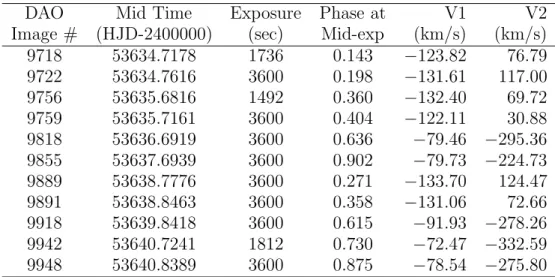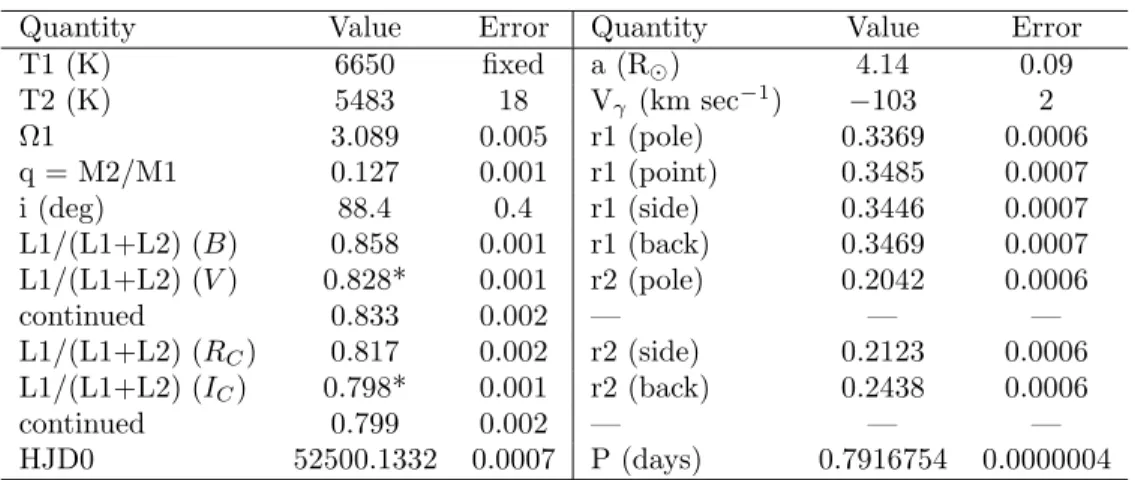Publisher’s version / Version de l'éditeur:
Information Bulletin on Variable Stars, 5970, 2011
READ THESE TERMS AND CONDITIONS CAREFULLY BEFORE USING THIS WEBSITE. https://nrc-publications.canada.ca/eng/copyright
Vous avez des questions? Nous pouvons vous aider. Pour communiquer directement avec un auteur, consultez la
première page de la revue dans laquelle son article a été publié afin de trouver ses coordonnées. Si vous n’arrivez pas à les repérer, communiquez avec nous à PublicationsArchive-ArchivesPublications@nrc-cnrc.gc.ca.
Questions? Contact the NRC Publications Archive team at
PublicationsArchive-ArchivesPublications@nrc-cnrc.gc.ca. If you wish to email the authors directly, please see the first page of the publication for their contact information.
NRC Publications Archive
Archives des publications du CNRC
This publication could be one of several versions: author’s original, accepted manuscript or the publisher’s version. / La version de cette publication peut être l’une des suivantes : la version prépublication de l’auteur, la version acceptée du manuscrit ou la version de l’éditeur.
Access and use of this website and the material on it are subject to the Terms and Conditions set forth at
The absolute dimensions of CU Sge
Nelson, R.H.; Terrell, D.; Gross, J.
https://publications-cnrc.canada.ca/fra/droits
L’accès à ce site Web et l’utilisation de son contenu sont assujettis aux conditions présentées dans le site LISEZ CES CONDITIONS ATTENTIVEMENT AVANT D’UTILISER CE SITE WEB.
NRC Publications Record / Notice d'Archives des publications de CNRC:
https://nrc-publications.canada.ca/eng/view/object/?id=a6c15ece-584f-47f5-8b5f-c8934907e38f https://publications-cnrc.canada.ca/fra/voir/objet/?id=a6c15ece-584f-47f5-8b5f-c8934907e38f
Number 5970
Konkoly Observatory Budapest
31 January 2011 HU ISSN 0374 – 0676
THE ABSOLUTE DIMENSIONS OF CU Sge
NELSON, ROBERT H.1,2; TERRELL, D.3
; GROSS, JOHN4 1
1393 Garvin Street, Prince George, BC, Canada, V2M 3Z1 email: b-o-b.nelson@shaw.ca [remove dashes]
2
Guest investigator, Dominion Astrophysical Observatory, Herzberg Institute of Astrophysics, National Re-search Council of Canada
3
Dept. of Space Studies, Southwest Research Institute, 1050 Walnut St., Suite 300, Boulder, CO, USA, 80302
4
Sonoita Research Observatory, Sonoita, AZ
CU Sge (= 2MASS J19242969+1629592), RA = 19h 24m 29.s 69, Dec = +16◦ 29′ 59.′′ 3 (2000.0) was discovered to be variable by Hoffmeister (1935) who supplied a finder chart and magnitude range but no period. Kurochkin (1949) seems to have determined a period but no other details are available. Numerous authors have determined times of minima (Nelson, 2010a) but no light curve is available and no analysis has been published.
During September of 2005 RHN took 11 spectra (10 ˚A/mm reciprocal dispersion, resolving power 10,000) at the Dominion Astrophysical Observatory (DAO) in Victoria, British Columbia, Canada; he then used the Rucinski broadening functions (Rucinski, 2004) to obtain radial velocity (RV) curves (see Nelson et al., 2006 for details). The spectral range was 5000-5263 Angstroms and the reciprocal dispersion, 10 Angstroms/mm. A log of DAO observations and RV results are presented in Table 1.
Table 1. Radial velocity observations of CU Sge.
DAO Mid Time Exposure Phase at V1 V2
Image # (HJD-2400000) (sec) Mid-exp (km/s) (km/s)
9718 53634.7178 1736 0.143 −123.82 76.79 9722 53634.7616 3600 0.198 −131.61 117.00 9756 53635.6816 1492 0.360 −132.40 69.72 9759 53635.7161 3600 0.404 −122.11 30.88 9818 53636.6919 3600 0.636 −79.46 −295.36 9855 53637.6939 3600 0.902 −79.73 −224.73 9889 53638.7776 3600 0.271 −133.70 124.47 9891 53638.8463 3600 0.358 −131.06 72.66 9918 53639.8418 3600 0.615 −91.93 −278.26 9942 53640.7241 1812 0.730 −72.47 −332.59 9948 53640.8389 3600 0.875 −78.54 −275.80
Photometric data were obtained at the Sonoita Research Observatory (SRO) in Septem-ber and OctoSeptem-ber of 2006 with the 0.35m robotic telescope and SBIG STL-1001E CCD camera. The differential observations with respect to TYC 1600-439 to were made with
2 IBVS5970
BV IC filters and no variability in the comparison star greater than 0.01m was detected with respect to the check star TYC 1600-451. Table 2 gives the details of the variable, comparison and check stars.
V RCIC data were also obtained at the Sylvester Robotic Observatory (SyRO) in Prince George, BC, Canada. (See Nelson, 2010b for more details.)
Table 2. Details of the variable, comparison and check stars.
Star Tycho ID R.A. (2000) Dec. (2000) V B − V
Variable 1600-1581 19:24:29.691 +16:29:59.293 11.2-11.9 0.51 Comparison 1600-0439 19:24:43.560 +16:30:01.169 11.10 0.35 Check 1600-0451 19:25:08.603 +16:44:28.145 10.03 0.34
The simultaneous light and radial velocity curve analysis was done by PHOEBE (Prsa and Zwitter, 2005), based on the Wilson-Devinney (WD) program (Wilson and Devinney, 1971; Wilson, 1979; Wilson, 1990) with weights for the individual curves determined by their scatter. The mean surface temperature of the primary star was fixed at a value of T1 = 6650 K based on the F5 spectral type (SIMBAD, no reference given), using the tables from Cox (2000).
Since the primary is in the transition region between stars that have convective en-velopes and those that have radiative enen-velopes, we investigated solutions for both cases. The fits were noticeably better, especially in the shoulders of the eclipses for the convective case, and theoretical values for the bolometric albedo and gravity darkening appropriate for convective envelopes were assumed for both stars in our final solution. Similar results were found by Nelson et al. (1995) for V728 Her.
The initial solution attempts were made assuming a detached configuration (WD mode 2) but the corrections for the secondary star’s surface potential consistently pushed it past the Roche lobe, so a semi-detached configuration (WD mode 5) was used. The parameters adjusted were the orbital semi-major axis (a), gamma velocity (Vγ),
inclina-tion (i), secondary mean surface temperature (T2), primary modified surface potential (Ω1), mass ratio (q) and primary wavelength-dependent luminosities (L1). We also used heliocentric Julian day as the independent variable and solved for the linear ephemeris parameters:
JD Hel Min I = 2452500.1332(7) + 0.7916754(4)E
Our initial attempts to fit the light curves were unsatisfactory due to a poor fit in the secondary eclipse. The theoretical curve, using the Van Hamme (1993) limb darkening coefficients and either the square root or logarithmic law, was insufficiently deep, so we decided to try adjusting the limb darkening coefficients. Since WD cannot adjust both coefficients of a non-linear limb darkening law, we used the linear law for these tests. The fit was noticeably improved, as shown in Figure 1. The final values for the limb darkening coefficients were substantially smaller than the theoretical values. For instance, the adjusted value for the B light curve was 0.14±0.06 whereas the theoretical value from the Van Hamme (1993) tables is 0.79. An interesting difference was found in the adjusted values for the V curve obtained at SRO and the one obtained at Prince George. The SRO value is 0.16±0.05 and the Prince George value was 0.26±0.05. The other passband in common between the two observatories, IC, did not show a significant difference, both
being 0.11±0.04. The V -band luminosity ratios in Table 3 also show differences. The two photometric datasets were obtained about a year apart, so it is unclear whether these differences are instrumental or a result of some time-dependent phenomenon of the
Table 3. Parameters from the final simultaneous light-velocity curve solution. The luminosity ratios marked with an asterisk, the values are from the 2005
SRO data while the others are for the 2006 SyRO data.
Quantity Value Error Quantity Value Error T1 (K) 6650 fixed a (R⊙) 4.14 0.09 T2 (K) 5483 18 Vγ (km sec−1) −103 2 Ω1 3.089 0.005 r1 (pole) 0.3369 0.0006 q = M2/M1 0.127 0.001 r1 (point) 0.3485 0.0007 i (deg) 88.4 0.4 r1 (side) 0.3446 0.0007 L1/(L1+L2) (B) 0.858 0.001 r1 (back) 0.3469 0.0007 L1/(L1+L2) (V ) 0.828* 0.001 r2 (pole) 0.2042 0.0006 continued 0.833 0.002 — — — L1/(L1+L2) (RC) 0.817 0.002 r2 (side) 0.2123 0.0006 L1/(L1+L2) (IC) 0.798* 0.001 r2 (back) 0.2438 0.0006 continued 0.799 0.002 — — — HJD0 52500.1332 0.0007 P (days) 0.7916754 0.0000004
system. The primary eclipse showed no fitting problems, so we used the theoretical limb darkening coefficients for the primary star.
A plot of the light curves and computed fits are shown in Figure 2 and the radial velocities and fits are shown in Figure 3. A three dimensional representation from Binary Maker 3 (Bradstreet, 1993) is shown in Figure 4. The absolute dimensions are listed in Table 4. The primary has a mass consistent with an F5 main sequence star, and a radius that indicates moderate evolution. The secondary is clearly an evolved object and the semidetached configuration is a clue that large-scale mass transfer has taken place.
Figure 1. The secondary eclipse in IC
show-ing the poor fit with a logarithmic limb dark-ening law and theoretical limb darkdark-ening coeffi-cients (dashed curve) for the secondary star, and the improved fit using a linear cosine law with an adjusted limb darkening coefficient (solid curve).
Figure 2. The observed light curves and fit us-ing the linear limb darkenus-ing law with adjusted coefficients for the secondary star.
Acknowledgements:
It is a pleasure to thank the staff members at the DAO (especially Dmitry Monin and Les Saddlemyer) for their usual splendid help and assistance
4 IBVS5970
Figure 3. The radial velocity curves and the computed fit.
Figure 4. Binary Maker 3 representation of the system – at phases 0.75 and 0.97.
Table 4. Absolute dimensions for CU Sge. Parameter Star 1 Star 2 Mass (M⊙) 1.36±0.09 0.17±0.01
Radius (R⊙) 1.42±0.03 0.92±0.02
M bol 3.4±0.1 5.2±0.1
Log g (cgs) 4.26±0.03 3.75±0.03
References:
Bradstreet, D.H., 1993, “Binary Maker 2.0 - An Interactive Graphical Tool for
Prelimi-nary Light Curve Analysis”, in Milone, E.F. (ed.) Light Curve Modelling of Eclipsing Binary Stars, pp 151-166 (Springer, New York)
Cox, A.N., ed, 2000, Allen’s Astrophysical Quantities, 4th ed., (Athlone Press, London). Hoffmeister, C., 1935, AN, 255, 401
Kurochkin, N.E., 1949, Perem Zvezdy, 6, 303 Nelson, R.H. et al., 1995, AJ, 110, 2400 Nelson, R.H. et al., 2006, IBVS, 5715
Nelson, R.H., 2010a, Eclipsing Binary O-C Files,
http://binaries.boulder.swri.edu/binaries/omc/ Nelson, R.H., 2010b, IBVS, 5951
Prsa, A. and Zwitter, T., 2005, ApJ, 628, 426. Rucinski, S. M. 2004, IAU Symp., 215, 17 van Hamme, 1993, AJ, 106, 2096
Wilson, R.E., and Devinney, E.J., 1971, ApJ, 166, 605 Wilson, R.E., 1979, ApJ, 234, 1054
Wilson, R.E., 1990, ApJ, 356, 613
∗This version of the paper contains corrections, and differs from the one appeared on-line originally.



